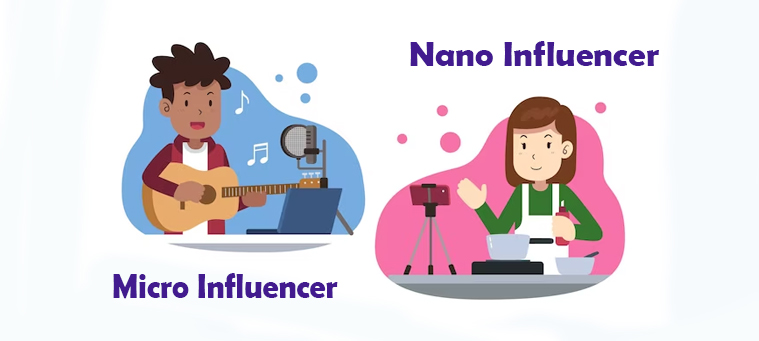Influencer marketing has become a popular and effective strategy for brands launching new products. It involves collaborating with influencers – individuals with large, engaged social media audiences in a niche – to promote launches. This can generate buzz, sales, and long-term success.
InfluencerMarketingHub research shows that successful influencer campaigns achieve $5.20 in earned media value (EMV) for every $1 of influencer investment, delivering a 520% return. When done right, influencer marketing provides quantifiable results and clear ROI.
Here are the key benefits of using influencers for launches:

Builds Pre-Launch Hype and Interest
One major advantage of using influencers for product launches is their ability to build hype and get audiences excited before the items are available for purchase. In the weeks and months leading up to a launch, brands can provide influencers with exclusive sneak peeks of products and have them share teasers, behind-the-scenes images, or information on their social channels.
“In 2017, Cosmetics brand Fenty Beauty generated $72M in earned media from pre-launch influencer buzz.”
Followers get intrigued about the upcoming launch and anxious to try the products, priming them to want to buy as soon as items drop. This type of anticipation marketing can ramp up interest and lead to immediate sales spikes at launch.
Drives Sales Immediately at Launch
On launch day, brands can tap into influencers’ ability to drive conversions and direct sales amongst their engaged bases of followers. Dedicated followers are used to trusting influencers’ recommendations and product endorsements. So when influencers share links to shop newly launched items, it often leads to a high rate of purchases and transactions in a short time frame.
“Personalized call-to-actions perform 202% better than basic CTAs. (HubSpot)”
Furthermore, influencers can create a sense of urgency about buying from the launch, reinforcing that quantities may be limited. This further incentivizes their audiences to buy right away.
Increases Brand Awareness
Influencer marketing also expands the awareness of product launches beyond a brand’s existing audience reach. Even influencers with smaller follower counts have the power to expose launches to new demographics that a brand may not have tapped into before. Their followers may not have previously heard about the company or been familiar with their products.
“Even smaller influencers expand reach. An influencer with just 1,000 engaged followers exposes a brand to 1,000 new sets of eyes.”
Collaborating with various influencers in different niches and verticals on launch campaigns can put brands in front of many fresh, relevant eyes. And it leads to increased visibility, impressions, and brand recognition.
Building Trust and Credibility
In addition to expanding reach, influencer partnerships lend credibility and build trust in newly launched products. When potential customers see influencers they admire vouching for a brand and its items, it sparks confidence in the quality and performance of the products. Especially if the influencers are actually demonstrating or reviewing the items first-hand.
“92% of consumers trust influencer recommendations over brand-sponsored ads. Their endorsements lend credibility to launches. (Forbes)”
The implicit endorsements make audiences more inclined to believe the products will live up to expectations and be worth purchasing. This third-party trust and validation is invaluable for convincing skeptical prospective buyers to give a new launch a chance.
Cost-Effective Marketing Channel
While brands pay influencers for their promotions and content, it still ends up being a very cost-effective strategy compared to other traditional advertising options. The production costs are free since influencers create the digital content themselves. And sponsored posts often outperform paid ads for things like engagement rates and return on investment.
“Influencer content outperforms ads for engagement. And their audiences yield higher purchase rates and ROI.”
Measurable Results and ROI
A significant advantage of working with influencers for product launches is the ability to track measurable results and ROI from the promotions. With unique promo codes or affiliate links, brands can closely monitor traffic, impressions, clicks, and conversions stemming directly from each influencer partnership. This data allows precise measurement of launch success and calculation of returns on influencer investment. Brands gain helpful analytics to refine launch campaigns and optimize future collaborations for the highest possible engagement and sales.
“Affiliate links and unique codes precisely track traffic, impressions, clicks, and conversions from each influencer.”
Quantifiable impact also further validates that the cost of sponsoring influencer content pays dividends. Compared to offline ads or branding plays, influencer posts provide crystal-clear metrics and attribution showing how they boost bottom lines.
Can Lead to Long-Term Connections and Sales
Lastly, using influencers for launches can spark ongoing collaborations, continual content, and long-term sales. If a launch campaign goes well, brands can sign influencers to multi-post deals or add them as consistent affiliate partners. This means they continue promoting the products post-launch and incentivizing sales for months or years down the line.
“Positive associations built give brands sales growth potential months or years after initial launch campaign.”
Even without formal agreements, influencers may organically feature brands again if they truly love the items. Either way, the positive opinions, associations, and follower relationships built through launch promotions lead to recurring revenue and growth potential.
Potential Downsides of Using Influencer Marketing
When leveraging influencers for product launches, there are risks brands should note, including inconsistent messaging that fails to convey key product features/benefits if influencers go off script; limited control around timing/content compared to owned channels; inauthentic promotions if influencers are not genuinely excited about the launch; and relationship management overhead since coordinating multiple influencer partnerships has complexity for brands.
Mitigating Challenges
To sidestep headaches when working with influencers, conduct vetting to select ideal partners, build out crisis contingency plans, implement tracking links for monitoring content performance, initially test smaller campaigns to optimize for larger ones, and provide very clear expectations and promotional requirements to keep messaging aligned. Alternatively, you can hire agencies with a great track record on influencer marketing and leave everything to them.
Following these best practices allows brands to benefit from influencer launch success while averting troubles.
How to Craft a Successful Influencer Marketing Strategy
When preparing to launch a new product, partnering with relevant influencers can provide immense strategic value. But brands must execute partnerships thoughtfully. Here are some tips:
- Research thoroughly to identify influencers whose audiences align best with target buyers
- Provide free samples of products pre-launch to spark genuine interest
- Brief influencers extensively on ideal messaging and selling points
- Use affiliate links and promo codes to quantify the impact of each partnership
- Maintain open communication to foster long-term relationships after launch
Following a targeted, personalized approach to working with influencers around launches allows brands to maximize benefits while ensuring content resonates. Ultimately, strategic influencer partnerships give launches the boost they need both immediately and over time.
FAQs with Answers
How many influencers should a brand partner with for a product launch?
3-5 influencers are ideal. Too many and messaging gets diluted. Start small with top partners for your goals and audience.
When should brands send product samples to influencers?
2-4 weeks pre-launch lets them properly try it out before creating content. Quicker turnarounds may lead to lower-quality promotions.
What is the ideal length of an influencer launch campaign?
Plan for 4-6 weeks of content from influencers, covering pre-launch teasers through post-launch reviews. Ongoing affiliate partnerships can extend it.
How much budget should brands allocate to influencer launch campaigns?
Industry benchmarks range from 10-30% of the total launch marketing budget. Consider starting small and scaling based on ROI.
Sum Up
Tapping into influencers’ audiences and trust for product launches can have tremendous benefits for brands. The hype they generate pre-launch followed by drives in transactions, impressions, and awareness at launch make influencer marketing a strategic slam dunk. And the affiliates, connections, and longevity formed set brands up for lasting success. For any DTC company ready to take a launch to the next level, collaborating with relevant influencers can provide that extra push and momentum.

